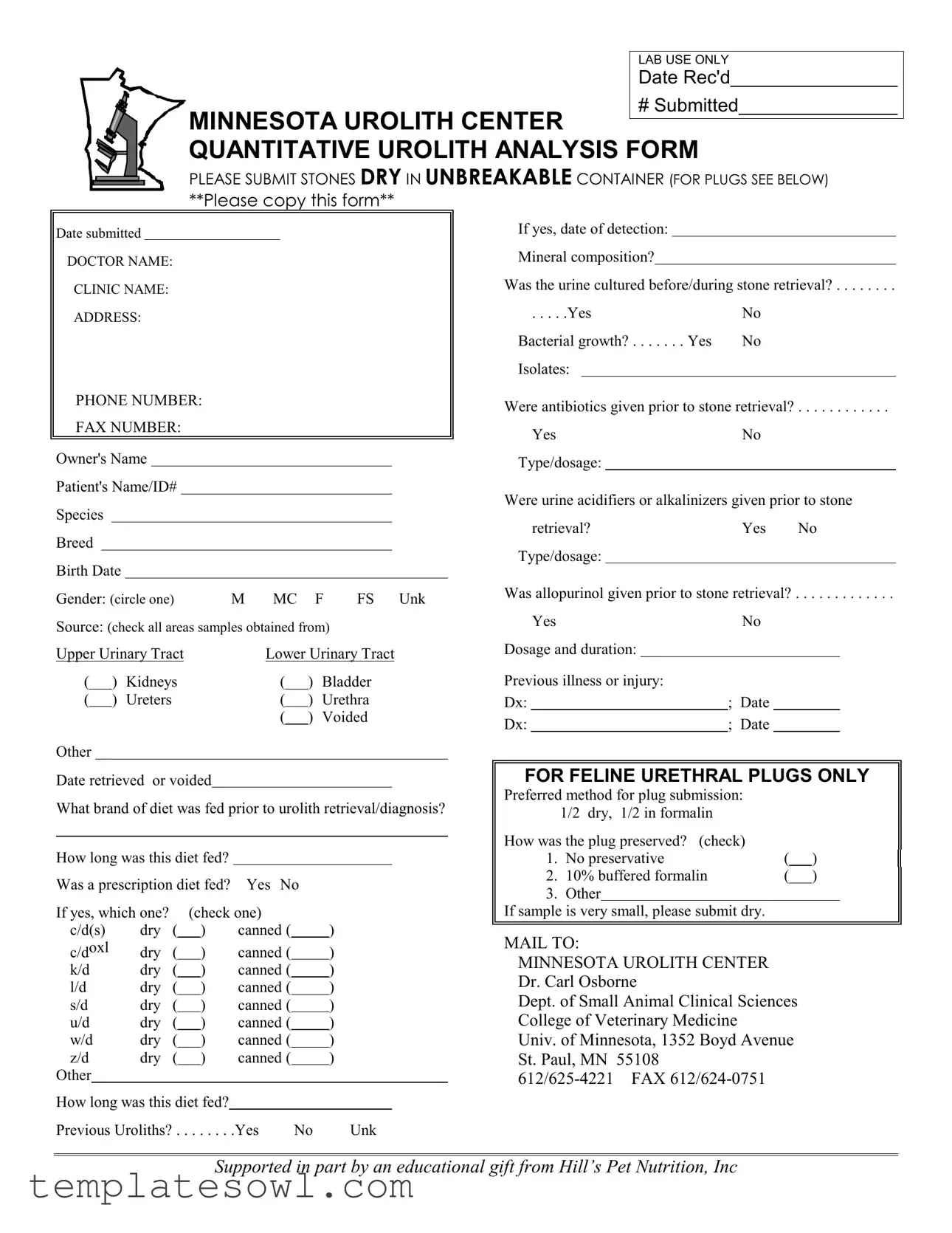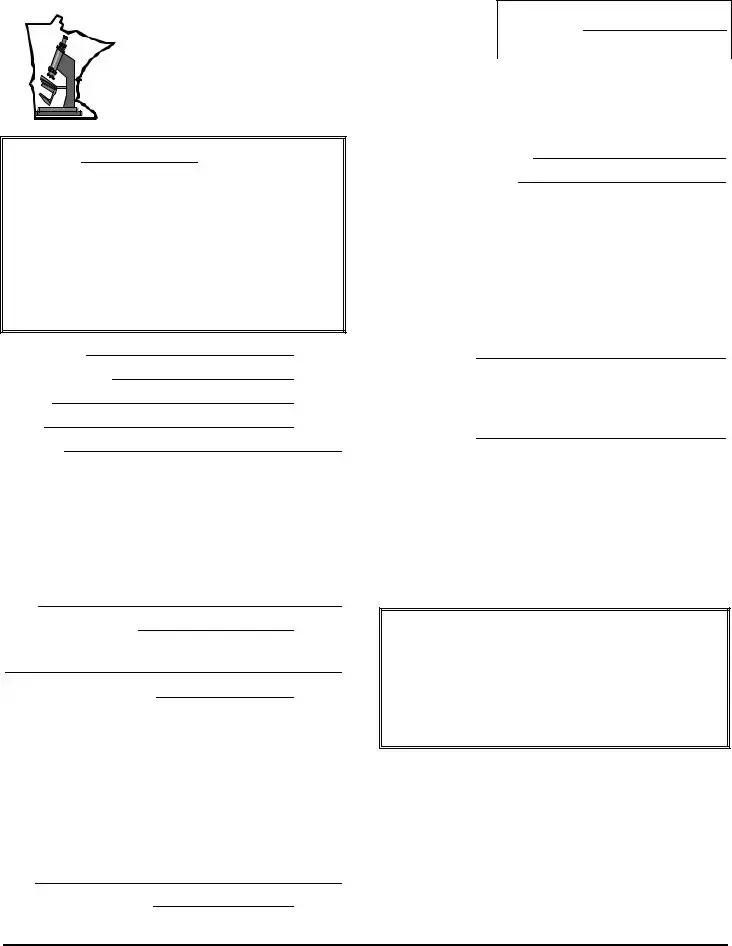LAB USE ONLY
DATE REC'D
# SUBMITTED
MINNESOTA UROLITH CENTER  QUANTITATIVE UROLITH ANALYSIS FORM
QUANTITATIVE UROLITH ANALYSIS FORM
PLEASE SUBMIT STONES DRY IN UNBREAKABLE CONTAINER (FOR PLUGS SEE BELOW)
**Please copy this form**
Date submitted
DOCTOR NAME:
CLINIC NAME:
ADDRESS:
PHONE NUMBER:
FAX NUMBER:
Owner's Name
Patient's Name/ID#
Species
Breed
Birth Date
If yes, date of detection:
Mineral composition?
Was the urine cultured before/during stone retrieval? . . . . . . . .
. . . . .Yes |
No |
Bacterial growth? . . . . . . . Yes |
No |
Isolates: |
|
|
Were antibiotics given prior to stone retrieval? . . . . . . . . . . . .
YesNo
Type/dosage:
Were urine acidifiers or alkalinizers given prior to stone
retrieval?Yes No Type/dosage:
Gender: (circle one) |
M |
MC |
|
F |
FS |
Unk |
Source: (check all areas samples obtained from) |
|
|
Upper Urinary Tract |
|
Lower Urinary Tract |
|
( |
) |
Kidneys |
|
( |
|
) |
Bladder |
|
|
|
|
|
|
|
|
|
|
|
( |
) |
Ureters |
|
( |
|
) |
Urethra |
|
|
|
|
|
|
( |
|
) |
Voided |
|
Other
Date retrieved or voided
What brand of diet was fed prior to urolith retrieval/diagnosis?
How long was this diet fed?
Was a prescription diet fed? Yes No
If yes, which one? |
|
(check one) |
|
|
c/d(s) |
dry |
( |
|
) |
canned ( |
) |
c/doxl |
|
|
|
|
|
|
|
dry |
( |
|
) |
canned ( |
) |
|
|
|
|
|
|
|
|
k/d |
dry |
( |
|
) |
canned ( |
) |
|
|
|
|
|
|
|
|
l/d |
dry |
( |
|
) |
canned ( |
) |
|
|
|
|
|
|
|
|
s/d |
dry |
( |
|
) |
canned ( |
) |
|
|
|
|
|
|
|
|
u/d |
dry |
( |
|
) |
canned ( |
) |
|
|
|
|
|
|
|
|
w/d |
dry |
( |
|
) |
canned ( |
) |
|
|
|
|
|
|
|
|
z/d |
dry |
( |
|
) |
canned ( |
) |
|
|
|
|
|
|
|
|
Other
How long was this diet fed?
Previous Uroliths? . . . . . . . .Yes |
No |
Unk |
Was allopurinol given prior to stone retrieval? . . . . . . . . . . . . .
|
|
|
|
|
|
|
Yes |
|
No |
Dosage and duration: |
|
|
|
|
Previous illness or injury: |
|
|
|
Dx: |
|
; |
Date |
|
Dx: |
|
; |
Date |
|
FOR FELINE URETHRAL PLUGS ONLY
Preferred method for plug submission: 1/2 dry, 1/2 in formalin
How was the plug preserved? (check) |
|
|
|
1. |
No preservative |
( |
) |
|
|
|
|
|
|
2. |
10% buffered formalin |
( |
) |
3. |
Other |
|
|
|
|
If sample is very small, please submit dry.
MAIL TO:
MINNESOTA UROLITH CENTER
Dr. Carl Osborne
Dept. of Small Animal Clinical Sciences
College of Veterinary Medicine
Univ. of Minnesota, 1352 Boyd Avenue
St. Paul, MN 55108
612/625-4221 FAX 612/624-0751
Supported in part by an educational gift from Hill’s Pet Nutrition, Inc
MINNESOTA UROLITH CENTER
Hasan Albasan, DVM, MS |
• |
UNIVERSITY OF MINNESOTA |
• Carl A. Osborne, DVM, PhD |
Kathleen Carpenter, CVT |
• |
College of Veterinary Medicine |
• |
Laura Pederson, BS |
Thomas F. Fletcher, DVM, PhD |
• |
1352 Boyd Avenue |
• David J. Polzin, DVM, PhD |
Frédéric Jacob, DVM |
• |
St. Paul, MN 55108 |
• |
Sheri Ross, DVM |
Lori Koehler, CVT |
• |
Lab Phone (612) 625-4221 |
• |
Laurie L. Swanson, CVT |
Chalermpol Lekcharoensuk, DVM • |
Fax (612) 624-0751 |
• |
Lisa K. Ulrich, CVT |
Jody P. Lulich, DVM, PhD |
• |
|
• |
|
_______________________________________________________________________________
WHAT PREVENTATIVE MEASURES SHOULD I TAKE UNTIL I RECEIVE QUANTITATIVE MINERAL ANALYSIS RESULTS?
Urolith formation is a process that typically takes several weeks (eg. infection induced struvite), to months (eg. calcium oxalate)rather than days. The most common "cause" of rapid recurrence of uroliths is incomplete removal at the time of surgery.
Until quantitative mineral analysis on the urolith is completed, we recommend the following
steps.
-Perform post-operative radiographs of patients with multiple urocystoliths. Double contrast cystography may be necessary if the urocystoliths were not easily observed on pre- operative survey films.
-If small stones are detected on post-operative films, they may be able to be removed non- surgically either by catheter retrieval1, or voiding urohydropropulsion2 after healing takes place.
-Feed a diet unlikely to enhance urolith formation. We typically feed a diet that avoids mineral excess, and promotes a neutral urine pH. We often feed a diet designed for mild to moderate renal insufficiency. If possible, feed a canned diet to promote dilute urine. Once urolith results are received, refer to accompanying recommendation sheets.
-Obtain cystocentesis urine samples to monitor for, and prevent secondary urinary tract infections.
1Osborne CA, Lulich JP, Unger LK: Nonsurgical retrieval of uroliths for mineral analysis. In Current Veterinary Therapy XI. pp 886-889, 1992.
2Lulich JP, Osborne CA, Unger LK, et al: Nonsurgical removal of urocystoliths by voiding urohydropropulsion. In Journal of the American Veterinary Medical Association. Vol 203, pp. 660-663, 1993.
Osborne CA, et al.: Canine and Feline Urolithiases: Relationship of Etiopathogenesis to Treatment and Prevention. In Canine and Feline Nephrology and Urology, Osborne and Finco 1995, pp 798-888


 QUANTITATIVE UROLITH ANALYSIS FORM
QUANTITATIVE UROLITH ANALYSIS FORM